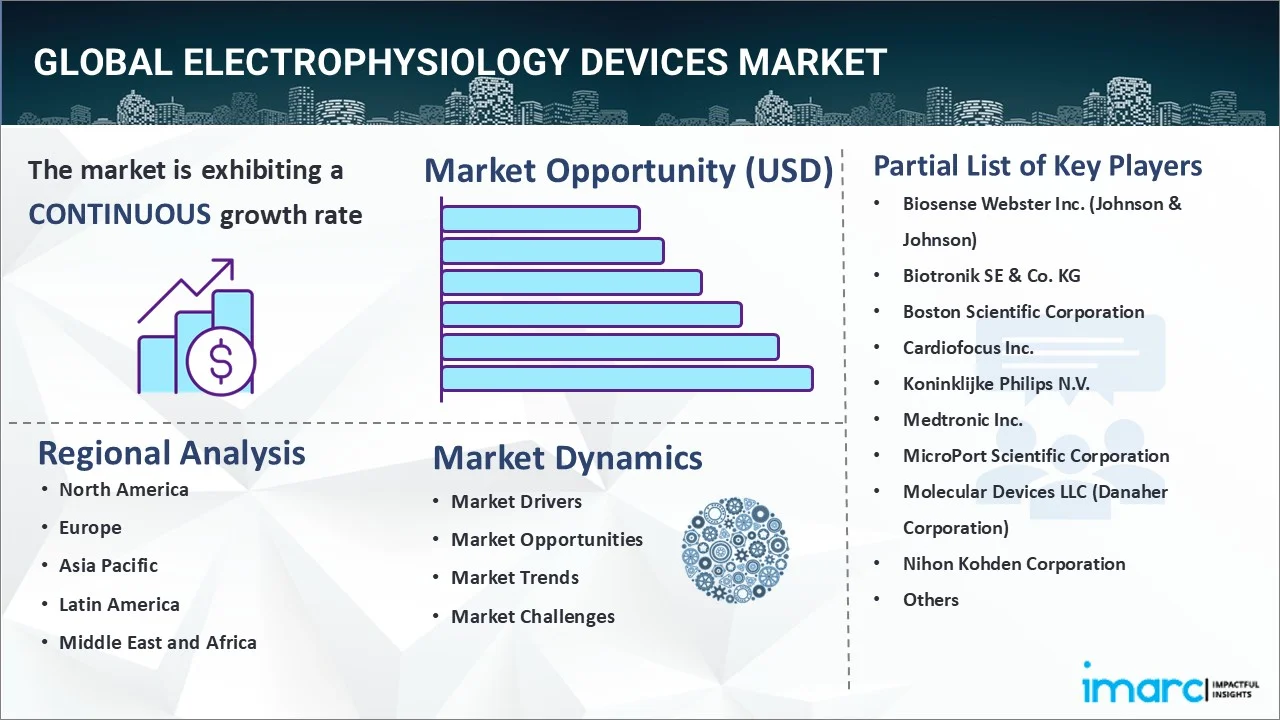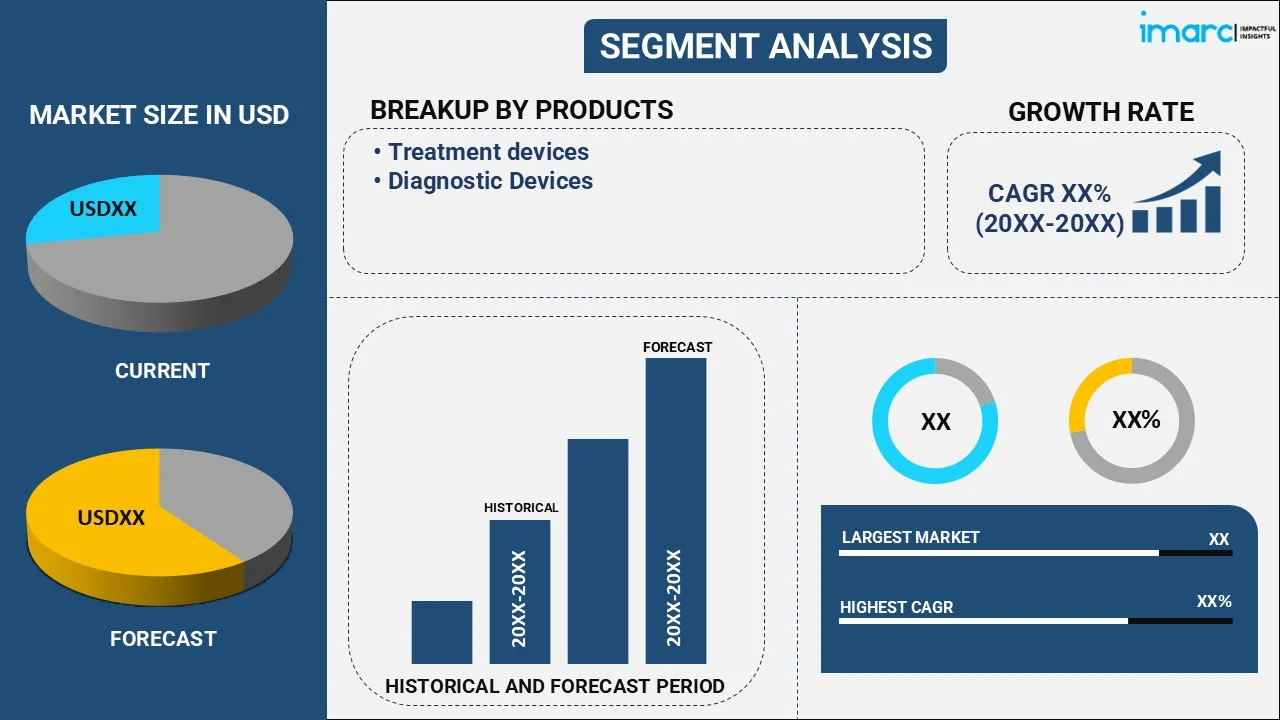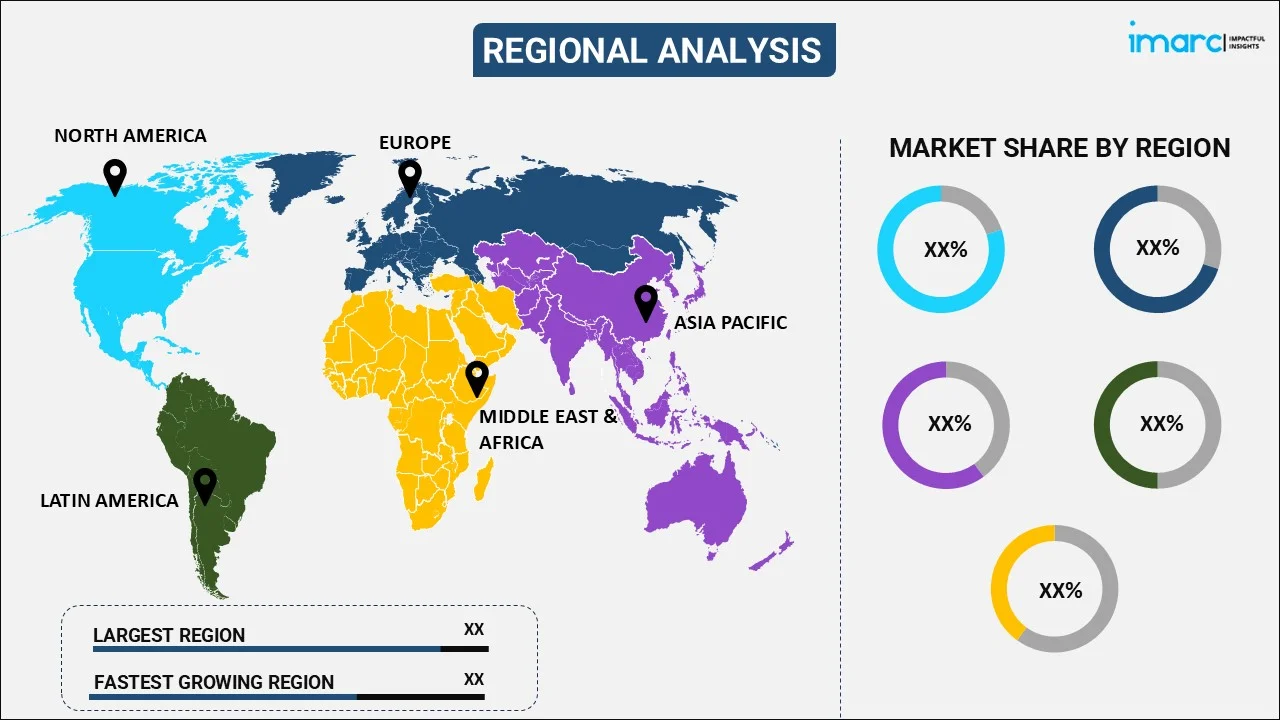
Electrophysiology Devices Market Report by Product (Treatment Devices, Diagnostic Devices), Indication (Atrial Fibrillation (AF), Supraventricular Tachycardia, Atrioventricular Nodal Re-entry Tachycardia (AVNRT), Wolff-Parkinson-White Syndrome (WPW), Bradycardia, and Other), End User (Hospitals, Diagnostic Centers, and Others), and Region 2025-2033
Electrophysiology Devices Market Size:
The global electrophysiology devices market size reached USD 6.7 Billion in 2024. Looking forward, IMARC Group expects the market to reach USD 12.9 Billion by 2033, exhibiting a growth rate (CAGR) of 7.58% during 2025-2033. Rising cardiac arrhythmia cases, technological advancements, growing demand for minimally invasive procedures, increasing healthcare expenditure, expanding outpatient care settings, favorable reimbursement policies, escalating awareness of early diagnosis, and the integration of artificial intelligence (AI) in medical devices are some of the factors driving the market growth.
|
Report Attribute
|
Key Statistics
|
|---|---|
|
Base Year
|
2024
|
|
Forecast Years
|
2025-2033
|
|
Historical Years
|
2019-2024
|
|
Market Size in 2024
|
USD 6.7 Billion |
|
Market Forecast in 2033
|
USD 12.9 Billion |
| Market Growth Rate 2025-2033 | 7.58% |
Electrophysiology Devices Market Analysis:
- Major Market Drivers: The rising prevalence of cardiovascular diseases (CVDs), technological advancements in minimally invasive procedures and therapies, and increasing aging population are factors boosting the electrophysiology devices market growth. In line with this, the burgeoning prevalence of arrhythmias and escalating awareness toward early diagnosis & treatment are other growth-inducing factors. Furthermore, technological advancements in electrophysiology mapping systems and soaring healthcare expenditure are providing a thrust to the market growth. Apart from this, growing market for catheter ablation procedures and high potential of integration of AI based electrophysiology devices are supporting the market growth.
- Key Market Trends: Rising demand for three-dimensional (3D) mapping and navigation systems and emergence of wireless and wearable monitoring devices are fueling the market growth. This is further bolstered by the implementation of machine learning (ML) to improve diagnostic accuracy. Moreover, the increasing utilization of robotically engineered electrophysiology and refined ablation technologies are creating a positive electrophysiology devices market outlook. In line with this, the increase in home monitoring and outpatient care and the growing need for monitoring patient data in real-time are fostering the market growth. Apart from this, the rise in clinical trials and the advancements in AI and teleoperated surgery are facilitating the market growth.
- Geographical Trends: North America is the largest market for electrophysiology devices followed by the Europe. The region is backed high healthcare spending and technological advancement. The region is also characterized by surging numbers of geriatric population with increased susceptibility towards cardiac problems and rapid adoption of minimally invasive procedures. In Asia-Pacific, the market is projected to witness the fastest growth due to the soaring investments in healthcare and growing awareness regarding early diagnostics and treatment in countries such as China and India.
- Competitive Landscape: Some of the major market players in the electrophysiology devices industry include Biosense Webster Inc. (Johnson & Johnson), Biotronik SE & Co. KG, Boston Scientific Corporation, Cardiofocus Inc., Koninklijke Philips N.V., Medtronic Inc., MicroPort Scientific Corporation, Molecular Devices LLC (Danaher Corporation), Nihon Kohden Corporation, Siemens Healthcare GmbH and Stereotaxis Inc., among many others.
- Challenges and Opportunities: The high costs of devices and procedures, low accessibility to advanced healthcare in the emerging regions, and regulatory approvals are key restraints for the market. Furthermore, the complexity of electrophysiology systems is a significant barrier for healthcare professionals. However, these challenges create umpteen opportunities. For instance, the rise in healthcare infrastructure development driven by government initiatives and burgeoning investments on research activities are driving the electrophysiology devices market revenue. Another crucial factor is the technological advancements and inflating per capita income.

Electrophysiology Devices Market Trends:
Rising Prevalence of Cardiac Arrhythmias
Increasing prevalence of cardiac arrhythmias such as atrial fibrillation (AF) and various other malignant are driving the market growth. According to the industry reports, atrial fibrillation (AF), known as the electrical or signaling/flutter problem in the heart, is affecting almost 2.7 million people in United States. AF is the most common cause of strokes and heart failure, which is creating a growing burden on health services. In addition, expanding technological advancements and disposable income has boosted awareness about arrhythmias among patients, due to which they prefer early diagnosis and treatment.
Technological Advancements in Electrophysiology Devices
The growth of the electrophysiology devices market is primarily bolstered by the rapid technological advancements. 3D mapping systems and other innovations enable cardiologists to design specified models of the heart's electrical activity, which improves diagnosis and treatment for patients suffering with arrhythmias. Additionally, the improvements in catheter ablation technologies helps reduce procedural risks, while minimizing patient recovery times and increasing success rates. In line with this, the use of robotic-assisted systems in electrophysiology has also improved the precision and control during procedures, which is providing a considerable boost to the market growth.
Growth of Minimally Invasive Procedures
Minimally invasive (MI) electrophysiology procedures can reduce recovery times, hospital stays, and procedural risks, which is why they are witnessing a considerable demand for the treatment of patients. Procedures such as catheter ablation, which are used to treat arrhythmias, provide a less traumatic alternative to the standard surgeries. This further enables an accurate diagnosis and enhances the results of treatment at a reduced cost and strain of surgeries on patients. Apart from this, the development of imaging and mapping technologies, in turn, has made MI interventions less cumbersome, which is facilitating the market growth.
Electrophysiology Devices Market Segmentation:
IMARC Group provides an analysis of the key trends in each segment of the market, along with forecasts at the global, regional, and country levels for 2025-2033. Our report has categorized the market based on product, indication, and end user.
Breakup by Product:

- Treatment Devices
- Implantable Cardioverter Defibrillators (ICDs)
- Automated External Defibrillators (AEDs)
- Pacemakers
- CRT-P
- CRT-D
- Catheters
- Others
- Diagnostic Devices
- Holter Monitoring Devices
- Diagnostic Electrophysiology Catheters
- Electrocardiograph (ECG)
- EP Mapping & Imaging Systems
- Insertable Cardiac Monitors (ICM)
- Others
Diagnostic devices accounts for the majority of the market share
The report has provided a detailed breakup and analysis of the market based on the product. This includes treatment devices (implantable cardioverter defibrillators (ICDs), automated external defibrillators (AEDs), pacemakers, CRT-P, CRT-D, catheters, and others) and diagnostic devices (holter monitoring devices, diagnostic electrophysiology catheters, electrocardiograph (ECG), EP mapping & imaging systems, insertable cardiac monitors (ICM), and others). According to the report, diagnostic devices represented the largest segment.
The diagnostic devices segment is driven by the increasing prevalence of cardiovascular diseases, particularly arrhythmias, which require precise diagnosis for effective treatment. Technological advancements, such as improved electrocardiographs (ECGs) and EP mapping systems, are enhancing diagnostic accuracy, leading to wider adoption of these devices. Additionally, the growing awareness of early detection and prevention of heart conditions is boosting demand for diagnostic tools like Holter monitors and insertable cardiac monitors (ICMs). Healthcare providers are increasingly relying on these devices for continuous monitoring and accurate data collection, which improves patient outcomes. The rise in minimally invasive diagnostic procedures, which offer quicker recovery times and reduce the need for hospital stays, is further contributing to the segment’s growth.
Breakup by Indication:
- Atrial Fibrillation (AF)
- Supraventricular Tachycardia
- Atrioventricular Nodal Re-entry Tachycardia (AVNRT)
- Wolff-Parkinson-White Syndrome (WPW)
- Bradycardia
- Other
Atrial fibrillation (AF) holds the largest share of the industry
A detailed breakup and analysis of the market based on the indication have also been provided in the report. This includes atrial fibrillation (AF), supraventricular tachycardia, atrioventricular nodal re-entry tachycardia (AVNRT), Wolff-Parkinson-White syndrome (WPW), bradycardia, and others. According to the report, atrial fibrillation (AF) accounted for the largest market share.
The atrial fibrillation (AF) segment is driven by the increasing global prevalence of AF, particularly among aging populations, which is a leading cause of stroke and heart failure. As awareness about AF grows, there is a rising demand for early diagnosis and effective treatment, prompting healthcare providers to invest in advanced electrophysiology devices. Technological advancements in diagnostic tools, such as 3D mapping systems and catheter ablation technologies, have improved the accuracy of AF detection and treatment success rates, boosting adoption. Additionally, the growing preference for minimally invasive procedures, which offer faster recovery times and reduced complications, is further accelerating demand for electrophysiology devices in AF management.
Breakup by End User:
- Hospitals
- Diagnostic Centers
- Others
Hospitals represents the leading market segment
The report has provided a detailed breakup and analysis of the market based on the end user. This includes hospitals, diagnostic centers, and others. According to the report, hospitals represented the largest segment.
The hospital segment is driven by the increasing prevalence of cardiovascular diseases, particularly arrhythmias, which require specialized electrophysiology procedures. Hospitals are equipped with advanced technology, such as 3D mapping and catheter ablation systems, enabling them to offer comprehensive cardiac care. The growing demand for minimally invasive procedures, which are often performed in hospital settings, further fuels this segment. Additionally, hospitals have skilled healthcare professionals capable of handling complex electrophysiology treatments, which boosts patient confidence in seeking care at these facilities. Rising healthcare expenditure, particularly in developed regions, allows hospitals to invest in cutting-edge electrophysiology devices, enhancing their capabilities.
Breakup by Region:

- North America
- United States
- Canada
- Asia Pacific
- China
- Japan
- India
- South Korea
- Australia
- Indonesia
- Others
- Europe
- Germany
- France
- United Kingdom
- Italy
- Spain
- Russia
- Others
- Latin America
- Brazil
- Mexico
- Others
- Middle East and Africa
North America leads the market, accounting for the largest electrophysiology devices market share
The report has also provided a comprehensive analysis of all the major regional markets, which include North America (the United States and Canada); Asia Pacific (China, Japan, India, South Korea, Australia, Indonesia, and others); Europe (Germany, France, the United Kingdom, Italy, Spain, Russia, and others); Latin America (Brazil, Mexico, and others); and the Middle East and Africa. According to the report, North America represents the largest regional market for electrophysiology devices.
As per the electrophysiology devices market dynamics, the North America’s regional market is driven by the increasing prevalence of cardiovascular diseases, particularly atrial fibrillation, among the aging population. Advanced healthcare infrastructure and widespread access to cutting-edge medical technologies support the adoption of electrophysiology devices across the region. Rising awareness of early diagnosis and treatment of heart conditions is boosting demand for these devices. Additionally, the growing preference for minimally invasive procedures has increased the use of catheter ablation and other electrophysiology tools. Continuous advancements in medical technology, such as 3D mapping systems and artificial intelligence (AI) integration, enhance the accuracy and outcomes of procedures, making them more attractive to both patients and healthcare providers, which is further driving the electrophysiology devices demand.
Competitive Landscape:
- The market research report has also provided a comprehensive analysis of the competitive landscape in the market. Detailed profiles of all major companies have also been provided. Some of the major market players in the electrophysiology devices industry include Biosense Webster Inc. (Johnson & Johnson), Biotronik SE & Co. KG, Boston Scientific Corporation, Cardiofocus Inc., Koninklijke Philips N.V., Medtronic Inc., MicroPort Scientific Corporation, Molecular Devices LLC (Danaher Corporation), Nihon Kohden Corporation, Siemens Healthcare GmbH, Stereotaxis Inc., etc.
(Please note that this is only a partial list of the key players, and the complete list is provided in the report.)
- Key players in the electrophysiology devices market are focusing on technological innovation and product development to stay competitive. They are investing in research and development (R&D) to create more advanced devices, such as next-generation catheter ablation systems and 3D mapping technologies, which offer improved precision and patient outcomes. Companies are also expanding their product portfolios by introducing new minimally invasive devices, making procedures less risky and more efficient. Strategic collaborations with hospitals and healthcare institutions are enabling key players to enhance their presence and strengthen their market share. In addition, many are adopting artificial intelligence and machine learning in their devices to enhance diagnostic capabilities and data interpretation, improving real-time decision-making during procedures.
Electrophysiology Devices Market News:
- In 2024, Biosense Webster presented data from the inspIRE clinical trial at the AF Symposium. This trial evaluated the safety and efficacy of the VARIPULSE™ Catheter and TRUPULSE™ Generator, marking the first PFA system fully integrated with electroanatomical mapping. The trial, conducted across 13 European centers, enrolled 226 patients, demonstrating a 97.1% success rate in pulmonary vein isolation (PVI) with no significant adverse events.
- In 2023, MicroPort EP achieved a major milestone by receiving CE and UKCA approval for its FireMagic™ TrueForce™ Ablation Catheter in the European Union and the United Kingdom. This catheter, used alongside the Columbus™ 3D EP Navigation System and OptimAblate™ Cardiac Generator, provides enhanced precision in catheter-tissue contact during ablation procedures for atrial fibrillation. It offers real-time feedback on lesion formation, improving the accuracy and safety of the procedure.
Electrophysiology Devices Market Report Scope:
| Report Features | Details |
|---|---|
| Base Year of the Analysis | 2024 |
| Historical Period | 2019-2024 |
| Forecast Period | 2025-2033 |
| Units | Billion USD |
| Scope of the Report | Exploration of Historical Trends and Market Outlook, Industry Catalysts and Challenges, Segment-Wise Historical and Future Market Assessment:
|
| Products Covered |
|
| Indications Covered | Atrial Fibrillation (AF), Supraventricular Tachycardia, Atrioventricular Nodal Re-Entry Tachycardia (AVNRT), Wolff-Parkinson-White syndrome (WPW), Bradycardia, Others |
| End Users Covered | Hospitals, Diagnostic Centers, Others |
| Regions Covered | Asia Pacific, Europe, North America, Latin America, Middle East and Africa |
| Countries Covered | United States, Canada, Germany, France, United Kingdom, Italy, Spain, Russia, China, Japan, India, South Korea, Australia, Indonesia, Brazil, Mexico |
| Companies Covered | Biosense Webster Inc. (Johnson & Johnson), Biotronik SE & Co. KG, Boston Scientific Corporation, Cardiofocus Inc., Koninklijke Philips N.V., Medtronic Inc., MicroPort Scientific Corporation, Molecular Devices LLC (Danaher Corporation), Nihon Kohden Corporation, Siemens Healthcare GmbH, Stereotaxis Inc., etc. |
| Customization Scope | 10% Free Customization |
| Post-Sale Analyst Support | 10-12 Weeks |
| Delivery Format | PDF and Excel through Email (We can also provide the editable version of the report in PPT/Word format on special request) |
Key Benefits for Stakeholders:
- IMARC’s industry report offers a comprehensive quantitative analysis of various market segments, historical and current market trends, market forecasts, and dynamics of the electrophysiology devices market from 2019-2033.
- The research report provides the latest information on the market drivers, challenges, and opportunities in the global electrophysiology devices market.
- The study maps the leading, as well as the fastest-growing, regional markets. It further enables stakeholders to identify the key country-level markets within each region.
- Porter's five forces analysis assists stakeholders in assessing the impact of new entrants, competitive rivalry, supplier power, buyer power, and the threat of substitution. It helps stakeholders to analyze the level of competition within the electrophysiology devices industry and its attractiveness.
- The competitive landscape allows stakeholders to understand their competitive environment and provides insight into the current positions of key players in the market.
Key Questions Answered in This Report
The global electrophysiology devices market was valued at USD 6.7 Billion in 2024.
We expect the global electrophysiology devices market to exhibit a CAGR of 7.58% during 2025-2033.
The rising geriatric population, along with the increasing awareness regarding numerous benefits of EP devices with minimal risks and higher success rates, represent some of the key factors driving the global electrophysiology devices market.
The sudden outbreak of the COVID-19 pandemic had led to the postponement of numerous elective treatment procedures for cardiological ailments to reduce the risk of coronavirus infection upon hospital visits, thereby limiting the demand for electrophysiology devices.
Based on the product, the global electrophysiology devices market can be segmented into treatment devices and diagnostic devices. Currently, diagnostic devices hold the majority of the global market share.
Based on the indication, the global electrophysiology devices market has been divided into Atrial Fibrillation (AF), Supraventricular Tachycardia, Atrioventricular Nodal Re-entry Tachycardia (AVNRT), Wolff-Parkinson-White syndrome (WPW), Bradycardia, and others, where Atrial Fibrillation (AF) currently exhibits a clear dominance in the market.
Based on the end user, the global electrophysiology devices market can be categorized into hospitals, diagnostic centers, and others. Among these, hospitals currently account for the largest market share.
On a regional level, the market has been classified into North America, Asia Pacific, Europe, Latin America, and Middle East and Africa, where North America currently dominates the global market.
Some of the major players in the global electrophysiology devices market include Biosense Webster Inc. (Johnson & Johnson), Biotronik SE & Co. KG, Boston Scientific Corporation, Cardiofocus Inc., Koninklijke Philips N.V., Medtronic Inc., MicroPort Scientific Corporation, Molecular Devices LLC (Danaher Corporation), Nihon Kohden Corporation, Siemens Healthcare GmbH, and Stereotaxis Inc.
Need more help?
- Speak to our experienced analysts for insights on the current market scenarios.
- Include additional segments and countries to customize the report as per your requirement.
- Gain an unparalleled competitive advantage in your domain by understanding how to utilize the report and positively impacting your operations and revenue.
- For further assistance, please connect with our analysts.
 Request Customization
Request Customization
 Speak to an Analyst
Speak to an Analyst
 Request Brochure
Request Brochure
 Inquire Before Buying
Inquire Before Buying




.webp)




.webp)












